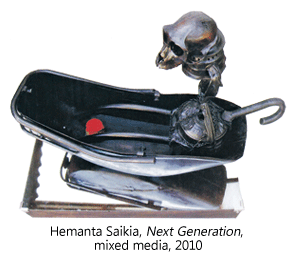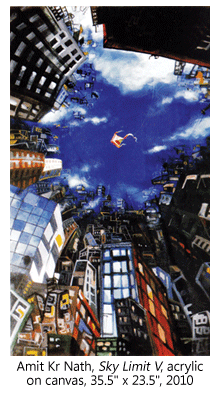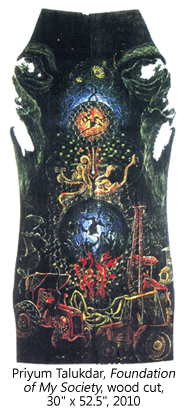- Prelude
- Editorial
- A Conversation with Jagdish Swaminathan
- Seeing is Very Important………
- Tormented Delineations and Violent Deformations
- Bikash Bhattacharjee: Subverting the Seen
- Bridging Western and Indian Modern Art: Francis Newton Souza
- Contesting National and the State: K K Hebbar's Modernist Project
- The Allegory of Return into the Crucial Courtyard
- Knowing Raza
- The Old Story Teller
- Beautiful and Bizarre: Art of Arpita Singh
- Feeling the Presence in Absence! Remembering Prabhakar Barwe
- Waterman's Ideal Fountain Pen
- Peepli Live: the Comic Satire Stripping off the Reality of Contemporary India
- Age of Aristocracy: Georgian Furniture
- Faking It - Our Own Fake Scams
- Scandalous Art and the “Global” Factor
- The Composed and Dignified Styles in Chinese Culture
- Visual Ventures into New Horizons: An Overview of Indian Modern Art Scenario
- The Top, Middle and Bottom Ends
- Top 5 Indian Artists by Sales Volume
- What Happened and What's Forthcoming
- The Month that was
- NESEA : A Colourful Mosaic
- Mumbai Art Sighting
- Art Events Kolkata
- Musings from Chennai
- Art Bengaluru
- Khoj, Kolkata Boat Project
- What a Summit!
- Ganesh Haloi at Art Motif
- The Other Self by Anupam Sud at Art Heritage, New Delhi
- Baul Fakir Utsav at Jadavpur
- Printmaking Workshop
- World's Greatest Never Before Seen Toy and Train Collection
- Previews
- In the News
- Christies: Jewellery Auction at South Kesington, London
ART news & views
NESEA : A Colourful Mosaic
Volume: 3 Issue No: 13 Month: 2 Year: 2011
North-East Opsis
by Moushumi Kandali
The Srimanta Sankardeva Kalakshetra of Guwahati, a unique multi cultural multimedia institution had been conceived as a grand exposition of the life and culture of the people of Assam as well as the North-East,  of its diverse ethnic groups and sub-groups who have created the cultural mosaic in all its beauty and splendour. Named after the great unifier of Assam and one of the greatest integrators of the Indian society of the fifteenth century, saint-scholar-writer-artist Srimanta Sankardeva, the Kalakshetra attempts to capture and convey the essence of the great seer's spirit, who preached the message of unity in diversity, sang the Bhakti- songs of glorious Bharata-Varsha and the universal brotherhood of man. The institution attempts for the preservation, restoration, research, promotion and development of the rich cultural heritage of the diverse ethnic communities inhabiting the region along with various initiations in the modern and contemporary cultural and art forms. Established in 1998 and spread over a sprawling campus of 16.28 hectares, the Kalakshetra has the following components to work for the fulfilment of the above objectives: A Sahitya and Sangeet Natak Bhavan, A Lalit Kala Bhavan, A Cultural Museum (Purbajyoti Museum), An International convention centre (Auditoria Complex), A Heritage Park, An Open Air Amphitheatre, Bakari Mancha or open air stage for performing arts, An Artists' Village, Audio Recording Studio & Archive, A Children Park, State Level Renewable Energy Park along with a regular Sound & Light Show about the history and culture of Assam.
of its diverse ethnic groups and sub-groups who have created the cultural mosaic in all its beauty and splendour. Named after the great unifier of Assam and one of the greatest integrators of the Indian society of the fifteenth century, saint-scholar-writer-artist Srimanta Sankardeva, the Kalakshetra attempts to capture and convey the essence of the great seer's spirit, who preached the message of unity in diversity, sang the Bhakti- songs of glorious Bharata-Varsha and the universal brotherhood of man. The institution attempts for the preservation, restoration, research, promotion and development of the rich cultural heritage of the diverse ethnic communities inhabiting the region along with various initiations in the modern and contemporary cultural and art forms. Established in 1998 and spread over a sprawling campus of 16.28 hectares, the Kalakshetra has the following components to work for the fulfilment of the above objectives: A Sahitya and Sangeet Natak Bhavan, A Lalit Kala Bhavan, A Cultural Museum (Purbajyoti Museum), An International convention centre (Auditoria Complex), A Heritage Park, An Open Air Amphitheatre, Bakari Mancha or open air stage for performing arts, An Artists' Village, Audio Recording Studio & Archive, A Children Park, State Level Renewable Energy Park along with a regular Sound & Light Show about the history and culture of Assam. All of these components strive to make the complex a living nerve centre of cultural excellence of Assam where the Lalit Kala Wing has been actively trying to play a role to promote modern/ contemporary visual art forms of the artists from north-east. With its two art galleries, one graphics studio, one workshop and one conference hall, the Lalit Kala wing of the Srimanta Sankardeva Kalakshetra (SSK) is providing a dynamic platform to the artist community of the region to develop and showcase their creative talents. The Lalit Kala section of the centre has a wide number of activities to its credit. Since its inception, the Lalit Kala section of SSK has been holding various exhibitions and workshops on paintings, drawings, graphics, sculptures, woodcrafts, photographs, and others, both at the state and national levels. Some of these are organised in collaboration with Lalit Kala Akademi, New Delhi, Lalit Kala Centre, Kolkata, All India Fine Arts and Craft Society (AIFACS), New Delhi, National Gallery of Modern Arts, to name a few. Solo Exhibitions by various artists are held regularly in the A.C. Art Gallery apart from other exhibitions on amateur artists of the State. Srimanta Sankardeva Kalakshetra is also regularly organising crafts fairs displaying the rich handloom, textiles and other traditional crafts of the region, to boost the morale of the cottage industry.
All of these components strive to make the complex a living nerve centre of cultural excellence of Assam where the Lalit Kala Wing has been actively trying to play a role to promote modern/ contemporary visual art forms of the artists from north-east. With its two art galleries, one graphics studio, one workshop and one conference hall, the Lalit Kala wing of the Srimanta Sankardeva Kalakshetra (SSK) is providing a dynamic platform to the artist community of the region to develop and showcase their creative talents. The Lalit Kala section of the centre has a wide number of activities to its credit. Since its inception, the Lalit Kala section of SSK has been holding various exhibitions and workshops on paintings, drawings, graphics, sculptures, woodcrafts, photographs, and others, both at the state and national levels. Some of these are organised in collaboration with Lalit Kala Akademi, New Delhi, Lalit Kala Centre, Kolkata, All India Fine Arts and Craft Society (AIFACS), New Delhi, National Gallery of Modern Arts, to name a few. Solo Exhibitions by various artists are held regularly in the A.C. Art Gallery apart from other exhibitions on amateur artists of the State. Srimanta Sankardeva Kalakshetra is also regularly organising crafts fairs displaying the rich handloom, textiles and other traditional crafts of the region, to boost the morale of the cottage industry.
Among these, the NESEA or the North-East States Exhibition of Art (initiated in 2004, comprising the seven north-eastern states and Sikkim), has come up as a major annual exercise to uplift and encourage the artists and generate awareness among the public about contemporary art. This year, the 7th annual exhibition of NESEA held from 1st Jan to 1st Feb, 2011, showcased 74 artworks selected from 335 artworks from all the eight states of North-East. 33 paintings, 11 sculptures, 21 prints and 9 numbers of drawings comprised the  exhibition unfolding a colourful mosaic of rendering in contemporary lingual expression, complimented by technical finesse. In the Jury's report, Vijay Bagodi and Siddharth Ghosh commented “While selecting we focused on the works having the essence of the North East, blended with the contemporary sensibility and aesthetic value. We are happy to have received some of the strong entries in graphics. Some of the received paintings, sculptures and drawings also speak volumes about the quality of those entries. Considering all these factors the Jury had decided to give one more special honourable mention besides ten stipulated honourable mentions.” Total five artists were awarded along with these eleven honourable mentions. The award winners are Priyum Talukdar (Assam), Wahengbam Khagemba Singh (Manipur), Pushpita Paul (Assam), Gautam Dhar (Assam) and Chirojyoti Bhattacharjee from Tripura. The artists with honourable mentions are Madhusudan Das, Trailokya Bordoloi, Jyanendra Nath Borah, Lalit Nath, Norjit Basumatary, Yumnam Sapha Wangam Apanthoi M, Binod Bora, Dhruba jit Sarma, Hemanta Saikia, Dolly Borkataki and Amit Kumar Nath.
exhibition unfolding a colourful mosaic of rendering in contemporary lingual expression, complimented by technical finesse. In the Jury's report, Vijay Bagodi and Siddharth Ghosh commented “While selecting we focused on the works having the essence of the North East, blended with the contemporary sensibility and aesthetic value. We are happy to have received some of the strong entries in graphics. Some of the received paintings, sculptures and drawings also speak volumes about the quality of those entries. Considering all these factors the Jury had decided to give one more special honourable mention besides ten stipulated honourable mentions.” Total five artists were awarded along with these eleven honourable mentions. The award winners are Priyum Talukdar (Assam), Wahengbam Khagemba Singh (Manipur), Pushpita Paul (Assam), Gautam Dhar (Assam) and Chirojyoti Bhattacharjee from Tripura. The artists with honourable mentions are Madhusudan Das, Trailokya Bordoloi, Jyanendra Nath Borah, Lalit Nath, Norjit Basumatary, Yumnam Sapha Wangam Apanthoi M, Binod Bora, Dhruba jit Sarma, Hemanta Saikia, Dolly Borkataki and Amit Kumar Nath.
The overall trait of the exhibition seems to be the fascination for the contemporary visual language predominant in the pan Indian scenario. The manifestation of a figuration-narration mediating the socio political concerns seems equally predominant. The nihilist aggression of the modernising spree and utter commercialisation and mechanisation too capture the ideological imagination of the artists as we witness a huge number of works focussed on the representations of various slices of cityscapes. A subdued nostalgic longing for the Nature, for those “good-old- days” is also manifested through some works. One interesting aspect has been the realistic representation of the rural life which for some of the artists of  this region is their very own qualitative lived experience. Few scenes of cultivating fields or people at harvest are pointer to this fact. Though such kind of representation at this juncture might look “ unfashionable” or redundant for some quarter, their selection in the exhibition by the Jury speak about a neutral vision where the thing that matters is the fineness of technicality and genuine expression of the experiential and existential predicament. Artists in the NESEA, have also adopted various mode of appropriation-re appropriation and subversion by infusing traditional myth-narrative-texts in modern context to seek newer interpretations of life-world and create new iconographies, new symbolism. They have tried to weave a definite figurative narrative idiom where myth, ideas, images, signs, beliefs or folkloristic visions derived from traditional/ tribal/indigenous collective subconscious are transported into modernist realms and ethos. At the very first glance their works might appear modernist in nature but at a closer look, they manifest the post-modernist strategies of pastiche, parody, wit, satire and black humour, expressed through popular cultural signifiers and languages. The overall impression of the 7th NESEA for the spectators has been a vibrant vibe where practicing artists from the North-East rendered a colourful mosaic of multiple lingual and mediumistic expression triggered by passion and ideological concerns both at the individual and collective level.
this region is their very own qualitative lived experience. Few scenes of cultivating fields or people at harvest are pointer to this fact. Though such kind of representation at this juncture might look “ unfashionable” or redundant for some quarter, their selection in the exhibition by the Jury speak about a neutral vision where the thing that matters is the fineness of technicality and genuine expression of the experiential and existential predicament. Artists in the NESEA, have also adopted various mode of appropriation-re appropriation and subversion by infusing traditional myth-narrative-texts in modern context to seek newer interpretations of life-world and create new iconographies, new symbolism. They have tried to weave a definite figurative narrative idiom where myth, ideas, images, signs, beliefs or folkloristic visions derived from traditional/ tribal/indigenous collective subconscious are transported into modernist realms and ethos. At the very first glance their works might appear modernist in nature but at a closer look, they manifest the post-modernist strategies of pastiche, parody, wit, satire and black humour, expressed through popular cultural signifiers and languages. The overall impression of the 7th NESEA for the spectators has been a vibrant vibe where practicing artists from the North-East rendered a colourful mosaic of multiple lingual and mediumistic expression triggered by passion and ideological concerns both at the individual and collective level.